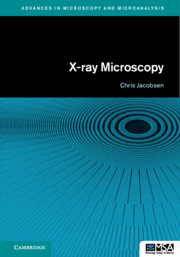Book contents
- Frontmatter
- Contents
- Contributors page
- Foreword
- 1 X-Ray Microscopes: a Short Introduction
- 2 A Bit of History
- 3 X-Ray Physics
- 4 Imaging Physics
- 5 X-Ray Focusing Optics
- 6 X-Ray Microscope Systems
- 7 X-Ray Microscope Instrumentation
- 8 X-Ray Tomography
- 9 X-Ray Spectromicroscopy
- 10 Coherent Imaging
- 11 Radiation Damage and Cryo Microscopy
- 12 Applications, and Future Prospects
- Appendix A X-Ray Data Tabulations
- References
- Index
2 - A Bit of History
Published online by Cambridge University Press: 28 October 2019
- Frontmatter
- Contents
- Contributors page
- Foreword
- 1 X-Ray Microscopes: a Short Introduction
- 2 A Bit of History
- 3 X-Ray Physics
- 4 Imaging Physics
- 5 X-Ray Focusing Optics
- 6 X-Ray Microscope Systems
- 7 X-Ray Microscope Instrumentation
- 8 X-Ray Tomography
- 9 X-Ray Spectromicroscopy
- 10 Coherent Imaging
- 11 Radiation Damage and Cryo Microscopy
- 12 Applications, and Future Prospects
- Appendix A X-Ray Data Tabulations
- References
- Index
Summary
Those who cannot remember the past are condemned to repeat it – George Santayana, Reason in Common Sense (Vol. 1 in The Life of Reason), 1905.
Janos Kirz contributed to this chapter.Röntgen and the discovery of X rays
The words of discovery are rarely those of Archimedes’ legendary shout of “Eureka!” or “I have found it!” as he supposedly leaped naked from his bathtub (good thing there weren't webcams in those days!). Instead, the words of discovery are more likely to be along the lines of “hmm … that's odd.” Such is the case of the discovery of X rays [Glasser 1933, Mould 1993].
At the time of their discovery, many investigators were carrying out experiments with various types of cathode ray tubes, but it was only Wilhelm Conrad Röntgen, Professor and Director of the Physical Institute at the University of Würzburg, who noticed some curious phenomena and decided to investigate further. Röntgen was 50 years old at the time, with a reputation for care in experiments even though his research in the physics of gases and fluids was not particularly cutting-edge. Cathode rays (which we would now call electron beams) were all the rage at the time, so Röntgen decided to investigate whether they would exit thin-walled Hittorf–Crookes tubes. To make it easier to use a phosphor to try to observe this, he surrounded a tube with black paper and worked in a darkened room. While setting up the experiment late on a Friday afternoon (November 8, 1895), he noticed that the phosphor was flickering in synchrony with the fluctuations of the glowing filament in the tube – even though the phosphor was some distance away, and with black paper in between! The odd phenomena immediately captured Röntgen's attention to the point that he did not notice an assistant entering the room later on to retrieve some equipment. When Röntgen's wife Bertha finally succeeded in getting a servant to coax him upstairs to their apartment on the top floor of the Institute, Röntgen ate little of his supper and spoke even less before returning that evening to the puzzle in the lab.
- Type
- Chapter
- Information
- X-ray Microscopy , pp. 5 - 22Publisher: Cambridge University PressPrint publication year: 2019



